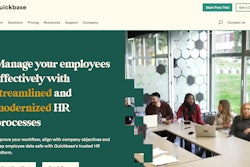
Thanks for joining us on Construction Tech Talk for another of our Product Snapshots. This is Technology Editor Charles Rathmann.
Packaged software is making rapid strides in helping contractors digitize established processes from estimating to bid letting to project management, change orders … but what if your contracting business has unique features? What if you’re involved in a joint venture or major project that requires a different set of workflows? There are no-code tools that enable what Gartner calls “citizen developers” to create enterprise solutions for these situations, and we’ll learn more about that because today, we’re talking about Quickbase.
Contractors who want to design their own software workflows to learn more about Boston-based Quickbase, which offers software enabling non-technical teams to rapidly create software solutions, without writing a lick of code. The company has more than five thousand five hundred customers including 21 hundred construction customers.
When I debriefed Quickbase CEO Ed Jennings, he hammered home the idea that contractors are more amenable to adopting technology if it does not force them to change how they do things. And there may be a lot to that, particularly when you get out of the back office and into the field or across company boundaries. Connecting what people are doing in different applications and creating better governance over things currently done in Excel … it looks like a good tool for that.
Personally, I am a believer in packaged software. As we progress towards what Gartner calls the Composable Enterprise though, where businesses orchestrate processes across multiple point solutions using PRECISELY the type of no-code integration Quickbase delivers, it is easy to see how the cost of multiple software subscriptions can add up. If Quickbase can replace multiple of these with a single subscription fee, there might be a financial win here combined with enhanced agility.
Quickbase was spun out of Intuit back in 2016, and is owned by private equity firms Vista Equity Partners and Welsh, Carson, Anderson and Stowe. In 2019, a significant component of the no-code user experience came into the fold when Quickbase bought Cloudpipes—which added a visually intuitive approach to enterprise workflow automation that connects multiple applications running in the business into a streamlined workflow.
Here, we see how easy it is to create a Pipeline—in this case, between Quickbase, Salesforce and slack—useful in managing activities around new business development activities in a contracting environment.
A user can specify that when a record is created in Quickbase, an object should be created in Salesforce. It’s a simple matter of dragging and dropping the record create trigger, and then, pulling down a drop down list of all the applications that work and play with Quickbase and the appropriate tables.
Then it’s a simple matter of creating an object in Salesforce and selecting as the account name the customer name from Quickbase.
Now there are people around the organization who probably ought to know a new account was created, so we look for the Slack application, select the POST A MESSAGE activity and then identify the channel where we want it to go.
Quickbase Pipelines became even more useful in 2009, when the company released RESTful APIs—these have a consistent structure that contain more of the information required to facilitate an integration, even for a citizen developer. In Quickbase’s case, the result is a shorter list of more useful integration end points, making it quicker and easier to connect Quickbase with one or more other software product’s APIs.
Let’s say you’re a homebuilder and want to bring in leads from HomeAdvisor’s lead feed. HomeAdvisor presents the fields to integrate in a JavaScript Object Notation or JSON format. The field names and definitions are all spelled out. You can create fields in Quickbase based on these fields in HomeAdvisor.
Not everything has to be made from scratch though—Quickbase Exchange offers an extensive library of applications built by other Quickbase users, and often these can get a customer far along the way to where they want to go. Then, the intuitive nature of the platform enables easy modification.
Now construction contractors may not have people who write code on staff, which means Quickbase might be a fit—but many of them don’t have a middle management or business analyst layer either—and these are the people who think about creating processes to solve problems. These are often the citizen developers. The folks at Quickbase knew this was a barrier to growth in construction, so in January of 2022 they bought their ISV partner, MCF Technology Solutions, which had a portfolio of construction solutions built out, including this Gannt Chart.
Then, in March, Quickbase formally launched these as standard products, along with applications for scheduling, materials management, a tool to connect project team members inside and outside of a contractor business and a Procore integration. And coming soon, Autodesk Construction Cloud and BIM 360 integrations. What’s more, the MCF team of about 40 professionals is available to guide contractors on their Quickbase journey.
If you ask me, all this was just super smart.
So how does this work? What’s going on behind the curtain?
Quickbase is a multitenant software as a service or sass product built around a proprietary in-memory database and reporting engine. The company has a hybrid web strategy, running their core application set in their own two data centers while other of their services are moving to the public cloud, including Amazon Web Services. CloudPipes was built on Google Cloud and that is where the Pipelines functionality still resides. There are monthly updates and patches and incremental updates.
It is not designed as a system of record, but rather as a way to create and orchestrate processes that modify data within a contactor’s system of record.
So … who is it for? Who’s a fit for this technology
CEO Jennings said the best fit customers fall into some specific categories.
Big real estate owner operators like big box retailers, multi-location retail banks—managing new construction and ongoing improvements or buildouts gravitate to Quickbase.
There are also the 21 hundred contractors and subcontractors.
State and local governments use the software on their infrastructure projects.
Then, there are those construction-adjacent organizations like residential solar and electric car charging station construction, where no single application seems to meet their needs.
Size in terms of revenue is less important to functional fit for Quickbase than the number of projects you’re managing and your requirements. The company serves a good percentage of the Fortune 500—but one of their marquee customers is Pennsylvania-based Lighthouse Electric, which has a bit over a hundred million in revenue. The smallest companies Quickbase may be a fit for … that may be about $5 million in revenue.
So let’s talk about price
And to be clear, that company size barrier of 5 million may be in part a function of the fact that an entry level subscription with Quickbase will be about two thousand dollars a month. While this is designed for citizen developers, Quickbase does have partners and the internal staff from MCF dedicated to consulting. So there may be a desire to bring on a consultant or guide on the side to help you realize value from Quickbase that would represent additional spend.
Customers can subscribe to Quickbase through a per-user base model—buy a certain number of users but they are pivoting more to a consumption-based model. This is important in construction where you want to share the application with people at other companies, as on a construction project.
If you are sharing the application with subcontactors or other partner collaborations it probably doesn’t make sense to pay for full users given that these partners will only be viewing and interacting with a narrow slice of the application. Quickbase in these cases offers a transactional entitlement with monitoring of consumption.
So … what’s the bottom line on Quickbase?
Quickbase is identified by analysts as a leader in the citizen developer or no-code development tool sector. Contractors going this route though will want to gauge their own ability to intelligently align technology to their business needs given their internal bandwidth and skill sets. The question of who will support the tools a contractor develops internally also ought to be examined as there will be no software vendor to trouble shoot or bring new capabilities or innovation to a custom solution. Quickbase may be a particularly elegant solution, however, for joint ventures, large projects and other settings where ad hoc teams come together and will benefit from the ability to structure digital workflows around the requirements of individual contracts or owners. And it may well be worth the money just to be able to create no-code integrations between multiple different solutions across a construction company, project or supply chain.















